AIS MOB devices, we’re in the learning phase!
One of the great things about the new AIS MoB beacons, like the recently FCC-approved Kannad SafeLink R10, is that they can send a short test signal over the air so that you can see how well your AIS plotter has been programmed to deal with one. But the fact that I’ve been encouraging folks to do just that makes it even more imperative that I report on a bug in very recent Garmin MFD software versions 7.30 7.20, 4.30 4.20, and 3.80 3.70. (See comments on the R10 entry above for more detail, but you probably don’t have the bug unless you updated your Garmin in last few weeks). While Garmin purportedly did a great job of programming its displays to respond usefully to an AIS MoB, apparently the test signal from an R10 can cause its MFDs to shut down, which was just discovered in Newport where the Bermuda Race fleet is gathering…
In fact, Garmin has dispatched two techs to Newport with 50 SD cards and are offering to do onboard software updates today and tomorrow, which is pretty impressive (especially since they make it so easy to do yourself via download). I’m not sure if it matters whether the AIS MoB test messages are received over NMEA 0183 or 2000 — which Garmin is particularly good at, as recently discussed — but who would have guessed that they could sometimes cause an MFD to shut down a mile or more away?
Oddly enough, this situation is this week’s second reminder that we all have a lot to learn about this new use of AIS. First came some info I picked up in Charlie Doane’s Kannad R10 test on WaveTrain. Yes, it was the inimitable Mr. Doane who probably created that R10-equipped MoB dummy pictured above, and rather than using the short test signal he got USCG permission to do a real test. Which was good in a way, as the Portland, ME, CG were able to report that they saw the signal four miles away. But not so assuring in the sense that “they also told us they saw nothing that suggested to them that the R10’s transmission was in fact a distress signal.”
As I understand it, any AIS plotter that receives an AIS MoB or SART signal is going to display it, because they use AIS message #1, the same dynamic data (position, speed, etc.) message as Class A transponders. And that message contains a particular Navigation Status field of “14” which is a tip-off that the sender is a distress device. Plus each SART MMSI, and only SARTs, begins with “972 970″ {MY mistake!} and each AIS MoB MMSI begins with “972.” Except that another thing I learned from Charlie’s article is that the number is often called an ID instead of an MMSI, which makes sense as they are not unique to a vessel or even referenced to one. I like the term “MMSI-like ID number” which I found in an early Jotron commercial level AIS SART document.
At any rate, the USCG NavCen “MMSI Overview” page now delineates this difference between AIS SARTs and MoB devices (below), and also describes an MMSI-like ID scheme for EPIRB-AIS devices that we haven’t really heard about yet. So the learning will continue! What I don’t know right now is what the AIS MoB’s like the Kannad R10 put in the SRM (Safety Related Message, #14) that they also transmit. Is is “ACTIVE SART” or “SART TEST” like the EasyRescue personal AIS SART I tested — which was developed before the AIS MoB standard was fully developed — or maybe “ACTIVE MOB” and “MOB TEST”?
And what you probably don’t know yet is what your AIS plotter will show besides a target with an unusual MMSI-like number. Will it throw up the SRM message as an alarm and even offer to set up a MoB waypoint, like the Raymarine E-Wide above did for the EasyRescue? I still have the EasyRescue and will test it with the displays I’ve got networked the Em-Trak B100 — including a Garmin 7212, which I’ll try before and after software updates — and I’ll put up more screen shots on this entry soon. If you’ve tried this sort of test, please send an image or just let us know how it went in the comments.
PS 6/14: Well, I got the title right! Almost no AIS plotting device I tried on Gizmo today treated the EasyRescue SART very well. The exception was the Raymarine e7, which alarmed and threw up an AIS SRM Alert “SART Test” with a Goto option like the E-Wide screen above. And while the i70 did alarm loudly, it also went into page Edit mode — I don’t know why — and put up some random text in a big font. Ray’s got some work to do here…
I tried two charting programs — Coastal Explorer with the Em-Trak B100 on NMEA 2000 (like the MFD tests) and Nobeltec TimeZero Trident with the Vesper Watchmate on NMEA 0183 — and while both showed the target, even with the correct icon in Nobeltec’s case, neither treated it differently than any other AIS target and neither showed the SRM text. The same was true of the Garmin 7212 running 3.60 software from last fall. And while the update to 4.30 software did not cause my Garmin to shut down (or hopefully others around Camden), it also did not show the SART Test at all. Garmin realized that itself today and the techs in Newport started installing older software instead of the new version. They’re definitely working on a real fix in Kansas, though.
But let’s not forget that these AIS SART/MoB devices definitely can work with any AIS plotting device, and do to some degree with almost every one right now. It’s just that the industry is just learning how to make best use of them as we learn what that might be.


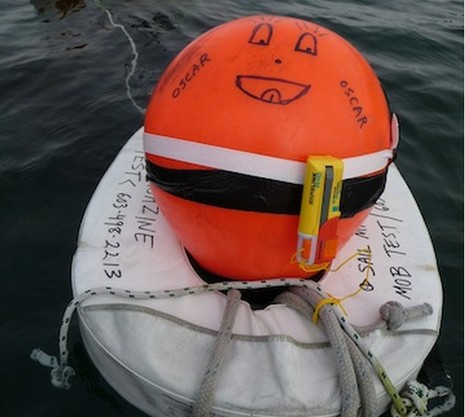
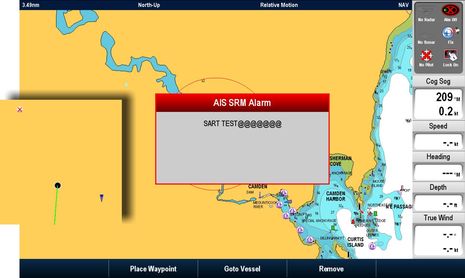

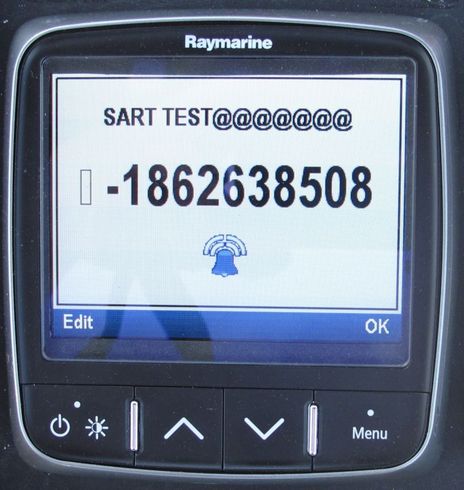
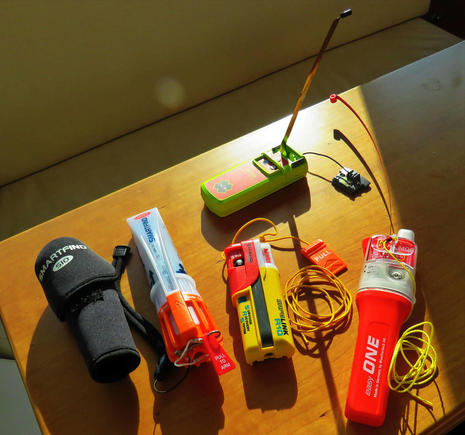
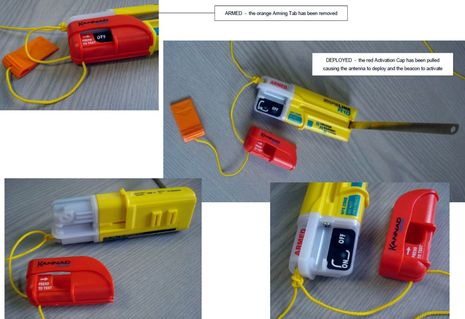

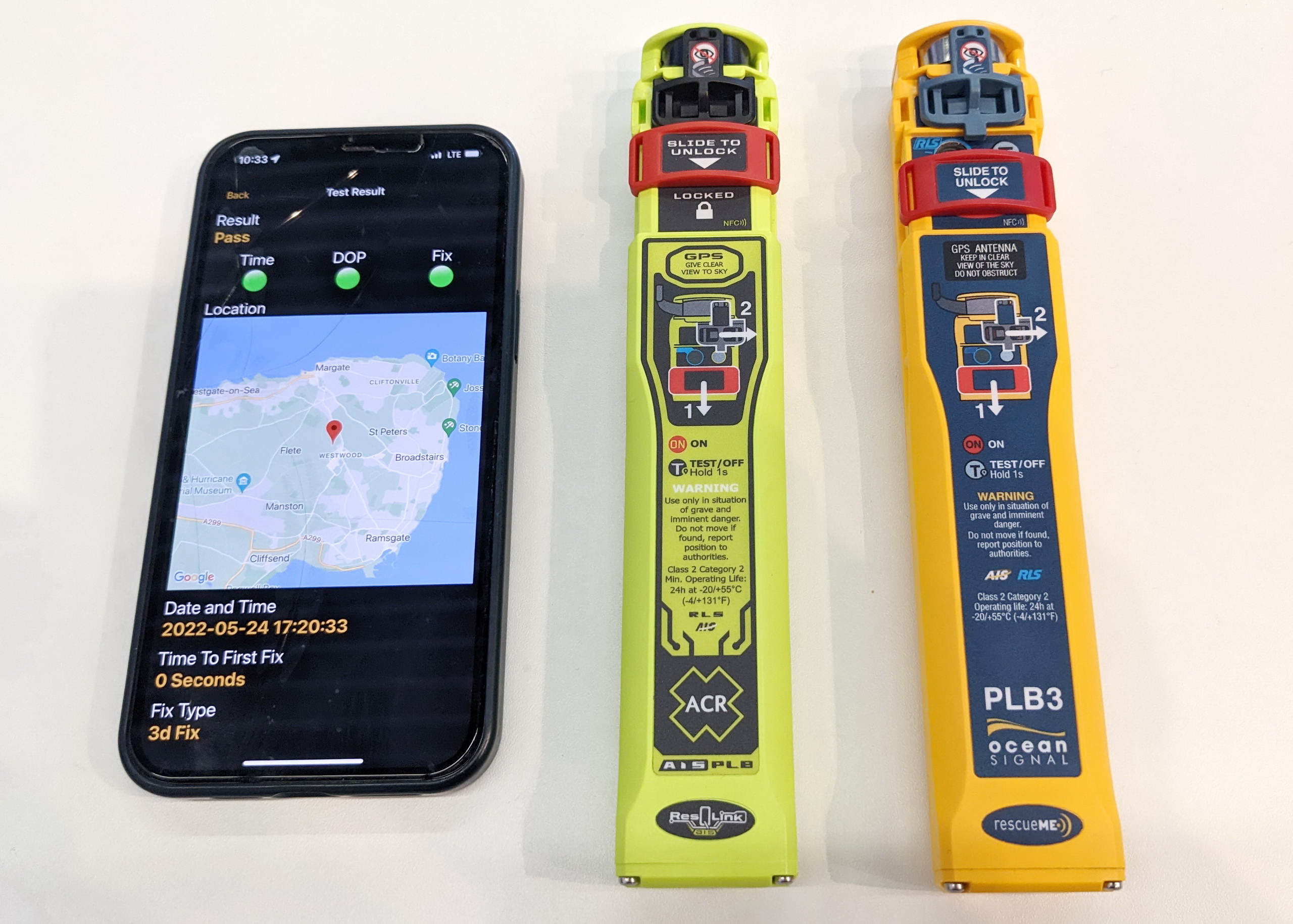







My Garmin AIS 600 transceiver has an pair of wires that can be wired to a switch and can be used to activate a distress signal. I haven’t wired this yet but wonder if activated what shows up on the chartplotter screen? Is the distress notice located in the ships data when clicked on or is it much more apparent?
This is a feature that was original when the AIS 600 was first introduced.
Richard – at one time Class B AIS devices were permitted to send a ‘Safety Related Message’ over AIS. This may (or may not) get displayed on another vessels MFD connected to an AIS receiver. It won’t be detected as a SART transmission.
Because of concerns AIS SRMs could be confused as a part of the GMDSS system (which they’re not) they were removed from the Class B AIS standard – more recent equipment doesn’t have this function.
“marinate” has that story correct (except that the IMO was also concerned about the use of SRMs by Class A vessels), as you can read if search “Safety Related Broadcast Messages” in this 2008 IMO document:
http://www.uscg.mil/imo/comsar/docs/comsar12-report.pdf
And in this USCG Alert:
http://www.navcen.uscg.gov/pdf/ais/USCG_Safety_Alert_0510.pdf
But it seems like the Broadcast SRM message 14 turned out to be great for SART and MoB devices whose goal is much more local and not likely to be confused with GMDSS distress technologies.
Thanks for that information. Now I know not to bother connecting the Garmin AIS 600 switch for the SRM feature. Garmin should have put out some sort of notice to customers who purchased the AIS 600 telling them not to connect the SRM wires.
It would be so easy for Garmin to reach all the registered owners to explain the change. I wonder how many Garmin AIS 600 owners have this SRM switch set up and think they can rely on it to broadcast a safety related message should they spring a leak.
Richard, I think your AIS 600 will transmit an SRM though I don’t know what the text will be and I haven’t tried it. I think a lot of parties fumbled the ball with SRMs, especially IMO, who first designed them into the AIS system and then decided they should be de-emphasized. And including myself, who might have looked it more closely and written about it here. (A USCG friend sent me the links above.)
It’s interesting that Class A AIS supports both Broadcast and Addressable SRMs and they can be predefined or custom. I think that the Class A displays support all that, and at least one has a full keyboard. But I’m not sure that even the Class A users got into using SRMs, especially after being alerted that “they may not be received, recognized or acted upon as Global Maritime Distress Safety Systems (GMDSS) messages would be by the Coast Guard, other competent authorities or maritime first responders.”
The Class B specification only permitted predefined Broadcast SRMs to be transmitted and apparently may didn’t even require that Addressable SRMs be decoded. Now the manufacturers have been encouraged to drop SRM transmission to avoid possible confusion, but Broadcast SRMs are working for these SART and MoB devices.
In the photo the AIS SART appears positioned higher then it would be on a real person. Has anybody done studies to show effective range when positioned more typically. Also are there any range considerations for transmission in a rougher sea. If the wearer finds themselves in the wave trough at each 30 second interval when the unit is transmitting; don’t normal VHF line of sight rules apply? This is something that the 121.5 beacon manufacturers suggest can happen with MOB devices that don’t transmit continually (AIS and DSC types). I’m sure it’s been well thought out and tested somewhere, so there must be info out there pertaining. Maybe some people in the know would respond with links to studies or tests? Thanks
Hi Talbot, If you read Charlie’s WaveTrain article (link above) you’ll see that the Kannad product manager said that the R10 would have better range if it were nearer the water, as it might likely be in real life. That was more news to me, but apparently the R10 is designed to use the water as a ground plane.
The AIS SART/MoB transmission timing scheme is pretty cleverly designed to deal with sea state. More info here: http://goo.gl/0BD0v
I just added a long PS about SART Test testing on Gizmo today. While it was a little discouraging (in the short run), I remain very bullish on the AIS SART/MoB concept.
Ben, according to the ITU standard, burst-mode AIS devices are supposed to have MMSI’s that start with 970. I’m not sure if MOB devices are implementing 972. Our testing verified the R10 uses 970 in accordance with the ITU. So you may find that various displays may not be handling 972 as a special type of target.
There are currently inconsistencies in the specs around Class B use of SRM (msg 14). As was previously noted, the previous version of IEC-62287 (the class B standard) allowed transmit of msg 14 with predefined text only and restrictions on how often it can be sent.
The most recent version of 62287 says that they should not be transmitted by a Class B, but that is inconsistent with ITU-R M.1371.4 which still lists it as optional. However, both say they are optional for receive. The same for receiving msg 12 (addressed SRM). But of course if you don’t process msg 14 then you won’t see the “SART ACTIVE” messages.
I’ve been testing the Kannad R10, and for what it’s worth the text in the Safety Related Message is:
— Beacon Test Mode —
MMSI: 972125131
SRM: MOB TEST
— Beacon Active Mode —
MMSI: 972125131
SRM: MOB ACTIVE
The actual text is:
“MOB TEST@@@@…” (41 total ‘@’s)
and
“MOB ACTIVE@@@@…” (57 total ‘@’s).
This isn’t exactly the text from the spec, but it’s probably close enough. If you are designing a decoder, make sure that you don’t need to see “SART-ACTIVE”.
When in the test mode, the beacon only transmits AIS Message 14 (Safety Related Broadcast), and when in active mode it also transmits (every few seconds) Message 1 with the NavStat set to “14” (AIS-SART)
I don’t know if Message 14 is repeated.
Thanks for the info, Jeff and Paul! But, Paul, are you sure that the R10 is not transmitting the Position message #1 in test mode? If that’s true, how can a user know how his or her AIS display is going to react to the real thing? I doubt, for instance, that an MFD will offer to create a MoB waypoint if it’s not given the MoB’s location, but maybe there’s something I’m not understanding?
It seems like we’re all learning and also that there’s a transition underway to differentiate between AIS SARTs from AIS MoB devices, though obviously both deserve special notice and response.
FYI, the Wamblee OneMan AIS SART, which sure looks like it’s meant to be used in MoB situations, seems to use the SART standards, like the year-old EasyRescue I’ve been testing. At least, the Wamblee W420 transmits SRM messages of SART ACTIVE or SART TEST. I don’t know if it’s MMSI-like ID number begins with 970 or 972.
http://www.wamblee.it/eng/W420.html
Ben, the R10 not transmitting Msg 1 (position report) in test mode surprised me, but I recorded several minutes of data and that’s what I saw. Perhaps they didn’t want to create any false alarms by sending Msg 1 NavStat = 14, and didn’t have any other options. The little user’s manual for the R10 seems to say it only sends the single Msg 14 in test mode, and that’s what I saw.
The test mode can be used to verify that the R10 transmitter is operational, and it supposedly verifies the GPS operation before it sends Msg 14. You are correct that you’re not going to be able to fully test your chartplotter (or similar AIS-aware device) without triggering the full MOB mode on the R10.
Before I did that here, I called the local USCG rescue center and discussed my plans. The Officer I spoke with was completely unfamiliar with the AIS SART device. I briefly filled him in on it, and gave him my position and the time when I would be testing. He promised to call me if anyone reported a MOB at my location. These guys did once call me when I was testing DSC-enabled VHF MOB function. It seems that my dummy-load was leaking! They were very understanding.
Ah… I just realized that we were testing with the R10’s sibling, a Smartfind S10. I guess there is a difference in test mode. The S10 that we tested, sent Msg 1 in test mode. Here’s a photo of one being shown on a WatchMate display.
And the S10 in Jeff’s Vesper photo has a 970 prefix, unlike Paul’s R10 with a 972 prefix. Something is not right here. Jeff, do you recall what the SRM text was for that Test? Are you sure you were using Test mode and not an actual activation?
I remember from the FCC documents that the R10 and S10 are essentially the exact same electronics and software in different cases, and thus were able to use the same tests for both products. I’d be very, very surprised if one transmitted a test with the Position message and one without. Maybe Paul has a faulty unit? Or maybe Kannad made a production change? Whatever is going on, maybe that’s what’s messed up Garmin’s decoding of the test messages?
I just re-ran my captured AIS NMEA logs for the two test cases (test mode, and MOB mode), and I can confirm that for my R10 the test mode transmits a single message 14, and then the unit flashes the “Test OK” signal and shuts down.
In the MOB mode, the unit transmits one message 14, then a Message 1 every few seconds (my logs don’t have timestamps, but I was recording for several minutes). I don’t know if the message 14 would have been repeated had I left the unit transmitting longer.
If anyone is interested, I would be happy to share my test logs. These are captured off-the-air using a SR161 receiver, and so have AIS traffic from nearby ships as well. The files are each under 15 kBytes.
Here’s a screenshot of NavMonPc displaying the R10:
http://www.navmonpc.com/Downloads/SART.png
This is from the next NavMon release, which I’m still working on. The current release doesn’t yet recognize SART beacons as anything special.
Ben, we didn’t take a photo of the message text, but I believe it was not in active-mode and the message was “SART ACTIVE”. Unfortunately, we gave the S10 back so I can’t readily give it another try.
Paul, the SR161 is a single channel receiver so you will only receive half of each burst resulting in individual messages within the burst being four seconds apart.
I believe the reason you don’t receive message 14 in test mode is because test mode should only send a single burst and due to another requirement message 14 can’t be the first burst.
oops.. I should have said that is *was* in active-mode and not test-mode when we tried it.
Going back over the comments above, it seems I had it backwards. The discussion is about not sending message 1 when in test mode. I thought it was about not sending message 14. So in a re-read of the spec, it appears that message 14 can indeed be sent in test mode if the manufacturer wants, but there can only be a single test-mode burst and hence only one message type.
I will re-test using one of my dual-channel AIS units (the SR-162 or the ACR Nauticast-B). As Jeff points out it’s possible that the single-channel SR-161 missed one (or some) of the messages.
Well, I have to apologize for the bad information. I re-tested the R10 using the ACR Nauticast-B to receive the test transmission, and here’s what I got:
11:55:32 PM 972125131 SRM: MOB TEST
11:55:32 PM 972125131 Message 1, NavStat: 15 (reserved)
11:55:32 PM 972125131 Message 1, NavStat: 15 (reserved)
11:55:40 PM 972125131 Message 1, NavStat: 15 (reserved)
11:55:40 PM 972125131 Message 1, NavStat: 15 (reserved)
11:55:43 PM 972125131 Message 1, NavStat: 15 (reserved)
11:55:43 PM 972125131 Message 1, NavStat: 15 (reserved)
11:55:47 PM 972125131 SRM: MOB TEST
11:56:35 PM 972125131 SRM: MOB TEST
Each transmission is on an alternate VHF channel. I have no idea why my previous test (with the single-channel receiver) didn’t pick up at least some of these position reports. Obviously more testing is in order.
Note that the NavStat field in the test message 1 is 15 (Reserved). When activated in MOB mode, message 1 NavStat = 14 (AIS-SART).
Thanks, Paul; that’s a relief. What I’m hoping is that the AIS SART and MoB devices all behave very similarly (except for the difference in 970 and 972 prefixes and the different pre-formatted SRM texts). Then hopefully the MFD and software developers will have an easier time writing code that responds appropriately to what I imagine will be a hearty competition of AIS safety products.
The Wamblee’s W420 use id 972, according ITU 5W Working group document.
Dear Ben,
Our W420 Wamblee in ACTIVE mode working fine in Garmin 720 and 4012 (the two units tested in Garmin Italy).
In test mode , if the AIS SART unit send a ID started as ‘970’ , the Garmin Chartplotter ignore the TEST sequence (no info, no AIS stored message)
In test mode , if the AIS SART unit send a ID started as ‘972’ , the Garmin Chartplotter go in SwitchOff and if you check the error trap logo you can see a message as ‘bad handled memory’, tipical of jump or trap error in memory leak.
I agree that is important that working in ACTIVE mode, but for example our customer want to check our unit and is not happy to see the Chart go off….
If you know a software contact in Garmin, please send to him my company email ([email protected]) if you like to know more details.
Thanks again, Daniele! I assure you that Garmin USA is getting your messages and I think they’ll be in touch.
In the meantime, it’s good to hear reassurance that the there is no problem with real SART and MoB messages, as Garmin has said. Your Test tests also correspond with mine. A Test message from the easyRescue, which uses the 970 prefix, does not make my 7212 shut down but does not show at all. I know Garmin is working on it!
I’ve been told via e-mail that the AIS MoB standards — like the 972 prefix and “MOB ACTIVE” SRM — are not quite finalized, which may account for some of the confusion here.
The ‘972’ prefix is released under ITU 5B Working Party on June 23, 2011 .
I.e. , the Kannad R10 use ‘972’ prefix according to this ITU document.
This ITU document can be download from cirm.org (CIRM is the organizzation responsable -as ITU declared – for the AIS SART numbering) here:
http://www.cirm.org/353.pdf
Results of live test of Kannad R10
Yesterday we did a live test on the Kannad device at the dock, right across from Coast Guard Island in Alameda. I called USCG and talked to Command SAR and also Sector San Francisco, to warn them we were doing the test.
We activated the unit and moved away from the boat. The target showed up on my Standard Horizon Matrix Gx2100 VHF/DSC/AIS radio, but only as a vessel with MMSI if 972xxxxxx. No DSC alarm, no special data.
I called USCG back after the test (the Kannad had been on and broadcasting for about 10 min), and they said there was no alarm or any DSC activity registered at their end, and that it should only be a matter of a few minutes for a received signal to percolate through their system.
Needless to say, this was a big disappointment. I was counting on the DSC alarm on the VHF (which is very loud) to wake the off-watch crew in the event of an emergency. We are double-handing in the Pacific Cup, which starts two weeks from today. But seemingly, the Kannad-type signal is not recognized by my gear or even USCG, even though my VHF radio is only a couple of years old.
I am thinking about sending these units back, as they are almost useless in practice. Any ideas??
Hi David, I’m afraid you’ve gotten confused between AIS and DSC MoB devices. They are two different technologies and standards, though it is possible that they’ll be combined by some manufacturer eventually. More detail here:
https://panbo.com/archives/2012/02/ais_dsc_mob_devices_the_standards_revealed.html
What might help you right now is the Digital Yacht AIS Lifesaver, which will alarm loudly on hearing your Kannad device. You’d have to feed it AIS info from the Matrix, but I think the radio could give you range and bearing to the MoB after the alarm got your attention. More info:
https://panbo.com/archives/2012/01/wireless_data_appliances_comar_nmea-2-wifi_dy_ais_lifeguard_.html
Wamblee also offers an AIS SART/MoB alarm.
Also Wamblee offer a AIS SART ‘Sniffer’; can recognize a AIS SART signal (970 or 972) received from a external AIS Receiver.
See http://www.wamblee.it/eng/W440.html
Or a WatchMate-670 display which will take the AIS data from the VHF radio and display it on a much larger and higher resolution screen and will give an alarm for your AIS-MOB.
Garmin release yesterday a software update for Chartplotters to finaly resolve the ‘switch-off’ problem when a MOB AIS SART was used in test mode.
Thanks to Olathe staff for the intense job.
Daniele Banfi, Wamblee
Thanks, Daniele! I see that Garmin also made some other changes that many AIS users will appreciate, like
“Added an Always Off setting to the other vessels collision alarm so that users do not have to disable the alarm each time the unit is powered on.”
I will definetly install and test this update.
I should also add that Daniele sent me photographs showing that all current Raymarine displays handle his company’s W420 AIS MoB devices quite nicely:
http://www.wamblee.it/eng/W420.html
Here are some display pictures taken from my Garmin 740 with the new software V3.9. Garmin did a nice job adding user AIS and SART control functions.
The selections for handling AIS Collision Alarms are On/Off (Off for the current event)/Always Off (Off for ALL subsequent underway periods).
AIS SART Displays
AIS Alarm Selections
When you select the Always Off choice it will ask you if you really want to make it.
Always Off Selection
You can select how AIS SART Tests are displayed …… by touching the appropriate menu and selecting either Receive/Ignore.
SART Displays
Thanks, BWP, those screens look good. I’ve got the update on the boat and should be receiving a Kannad R10 AIS MoB today, so will be able to test the new Garmin software with both that and the EasyRescue AIS SART. Screens soon!